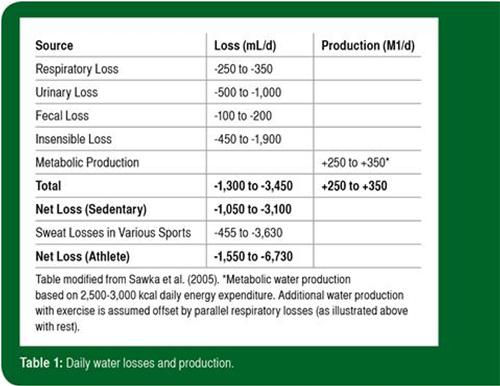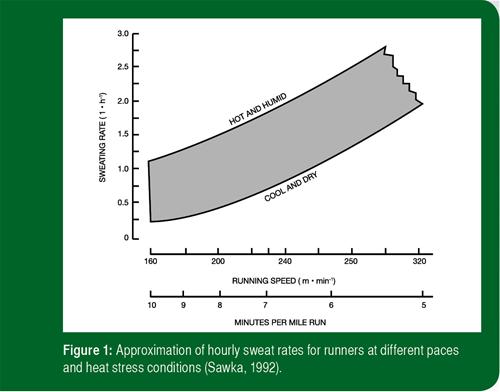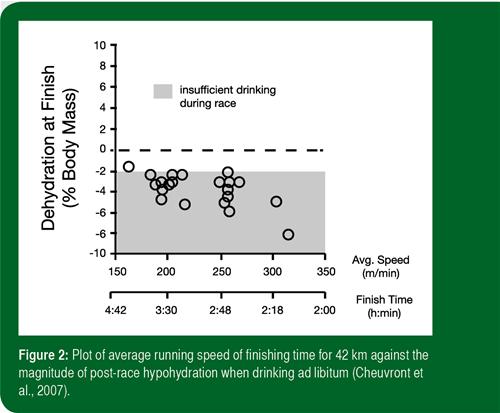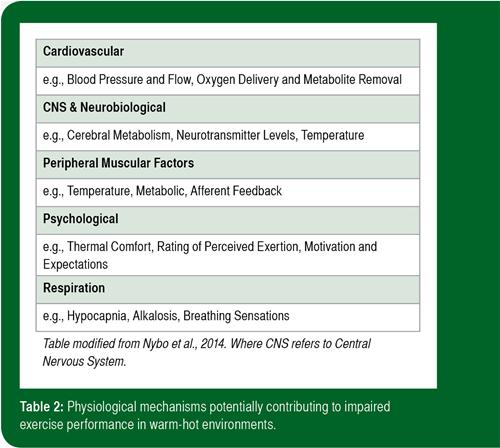KEY POINTS
-
Athletes exercising in warm-hot conditions have high sweat rates that are a function of the metabolic intensity and environmental heat load.
-
When sweat rates are high, ad libitum fluid consumption is often not sufficient to fully replace sweat losses (“voluntary dehydration”) and results in cumulative body water deficits.
-
A body water deficit of >2% of body mass (~3% of total body water for the average athlete) is defined as hypohydration.
-
Hypohydration does not alter aerobic exercise performance in cold-cool environments, and sometimes impairs aerobic exercise performance in temperate conditions.
-
Hypohydration usually impairs aerobic exercise performance in warm-hot environments.
-
When skin temperature exceeds 27°C (81°F), hypohydration impairs aerobic performance by an additional ~1% for every 1°C (1.8°F) skin temperature elevation.
INTRODUCTION
Body water and electrolyte imbalances are common when performing strenuous physical exercise and/or during exposure to the environmental extremes of heat (Sawka et al., 2007), cold (Freund & Young, 1996) and high altitude (Hoyt & Honig, 1996). In warm-hot environments, high sweat rates may be sustained for many hours resulting in body water and electrolyte imbalances (Montain et al., 2006). During cold and high-altitude exposures, body water deficits are partially due to increased urine production. However, sweat rates can also be elevated while performing strenuous physical work in high-altitude, cold environments, due to high radiant heat loads (Gonzalez et al., 2012) and wearing heavy clothing or equipment (Young et al., 2000). When body water loss exceeds 2% of body mass, aerobic exercise performance can be impaired (Sawka et al., 2007; Sawka et al., 2015).
FLUID BALANCE AND BODY WATER
Water (total body water) is the principal chemical constituent of the human body. For an average young adult male, total body water represents 50–70% of body weight (Institute of Medicine, 2005). Variability in total body water is primarily due to differences in body composition. Lean body mass is ~73% water and fat body mass is ~10% water (Institute of Medicine, 2005). Thus for an average athlete, a body water deficit of 2% of body mass will be ~3% of total body water and ~5-10% of total body water is turned over daily, distributed via obligatory (non-exercise) fluid loss avenues.
Table 1 provides the sources of daily water losses and production for sedentary and active populations (Sawka et al., 2005). Metabolic water is formed by oxidation of substrates and is roughly offset by respiratory water losses. Urine output generally approximates 1–2 L (1.05–2.11 qt.) per day but can be markedly increased when consuming large volumes of fluid. This large capacity to vary urine output represents the primary avenue to regulate net body water and solute balance across a broad range of fluid intake volumes and losses from other avenues (Institute of Medicine, 2005). Sweat losses vary widely and depend upon the physical activity level and environmental conditions with ambient temperature, radiant heat load and high humidity, all markedly elevating sweating requirements (Gonzalez et al., 2009). Figure 1 provides an approximation of hourly sweat rates for athletes running at different speeds and exposed to different environmental conditions (Sawka, 1992). Sweat rates of >1 L/h (1.05 qt.) are common due to either high metabolic intensities and/or environmental heat stress.


Net body water balance (loss = gain) is regulated remarkably well on a day-to-day basis as a result of thirst and hunger drives, coupled with ad libitum access to food and beverage to offset water losses (Institute of Medicine, 2005). This is accomplished by an intricate interplay between neuroendocrine and renal responses to body water volume and electrolyte changes, as well as non-regulatory social-behavioral factors. These physiological homeostatic re-sponses collectively ensure that small degrees of over- and under-hydration are readily compensated in the short term (Institute of Medicine, 2005).
During periods of high sweat rates (>1.0 L/h; 1.05 qt./h), humans practicing ad libitum drinking will often under-consume (Adolph, 1947; Adolph & Dill, 1938; Bean & Eichna, 1945; Greenleaf et al., 1983; Greenleaf & Sargent, II, 1965) and incur a body water deficit (Cheuvront & Haymes, 2001; Sawka et al., 2007). Figure 2 plots body water deficits incurred by runners practicing ad libitum drinking at different paces in marathon races contested across a range of cool-to-warm environmental conditions (Cheuvront et al., 2007). Note that most of the runners achieved body water deficits >2% of their initial body mass.
BODY WATER DEFICITS
Hypohydration is defined as a body water deficit greater than normal daily fluctuation (Cheuvront & Kenefick, 2014). Changes in hydration status can be assessed by a variety of body measures; however, they all have serious limitations (Cheuvront & Kenefick, 2014). Because of low measurement variability, change in body mass provides the most sensitive and simplest measure to determine acute changes in body water for all types of dehydration (Cheuvront et al., 2013; Cheuvront & Kenefick, 2014; Institute of Medicine, 2005; Sawka et al., 2007). Body water deficits >2% of body mass exceed two standard deviations in normal body mass variability (Adolph & Dill, 1938; Cheuvront et al., 2004) and represent an approximate threshold (based on plasma volume reductions and plasma osmolality increases) where compensatory fluid regulatory actions occur (Cheuvront et al., 2013, 2014).

Incomplete fluid replacement decreases total body water, and as a consequence of free fluid exchange, affects each fluid space and will decrease blood (plasma) volume (Institute of Medicine, 2005). Plasma volume decreases because it provides the fluid for sweat, and as a result, osmolality increases because sweat is hypotonic (sodium poor) relative to plasma. The plasma hyperosmolality acts to pull fluid from the intracellular to the extracellular space to enable the defense of plasma volume when individuals become hypohydrated (Mack & Nadel, 1996). Use of diuretics (e.g., furosemide) for medical purposes increases urine formation and generally results in the loss of both electrolytes and water. Diuretic-induced hypohydration generally results in an iso-osmotic hypovolemia, with a much greater ratio of plasma loss relative to intracellular water loss that is typical of exercise or heat induced hypohydration (Cheuvront et al., 2013). Consistent with this, the environmental stressors of cold (Young et al., 1987) and high altitude (Hoyt & Honig, 1996) stimulate urine and electrolyte output, thus inducing an iso-osmotic hypovolemia (Cheuvront et al., 2013)
ENVIRONMENT AND AEROBIC PERFORMANCE
Ambient Temperature
During exercise in the heat, the most significant physiological burden is to support high skin blood flow for heat dissipation (Nybo et al., 2014; Sawka et al., 2011c). Skin temperature is elevated in proportion to ambient temperature and humidity. Figure 3A illustrates the generally linear relationship between ambient temperature and skin temperature (Adams, 1977) with a de novo 95% confidence interval calculation to illustrate the modifying effects of air flow and sun on the grouped relationship. Skin temperatures will be elevated toward the high end of the confidence interval by high humidity, wearing uniforms/clothing that insulate and exposure to solar radiation. Skin temperatures will be reduced toward the lower end of the confidence interval by exposure to high air motion, which increases sweat evaporation. Warm-hot skin is associated with a greater skin blood flow and cutaneous venous compliance, which augments cardiovascular strain (Nybo et al., 2014; Sawka et al., 2011c). In general, the warmer the skin, the greater the skin blood flow response and the greater the heart rate elevation during exercise in the heat. The elevation in heart rate acts to reduce cardiac filling and stroke volume, thus providing a challenge to sustain blood pressure (Nybo et al., 2014; Sawka et al., 2011c). Therefore, during exercise in the heat with high sweat rates, there is the simultaneous problem of reduced plasma volume from dehydration in addition to elevated skin blood flow requirements. This dual perturbation (reduced plasma volume with increased skin blood flow) is likely an important physiological mechanism (via the cardiovascular system) contributing to impaired aerobic performance (Cheuvront et al., 2010; Cheuvront & Kenefick, 2014; Nybo et al., 2014; Sawka et al., 2015).

It is generally accepted that heat stress alone will impair aerobic performance (Nybo et al., 2014), while cold stress alone does not impact aerobic performance unless the temperature is sufficient to adversely impair skeletal muscle function and nerve conduction (Sawka et al., 2011a). The earliest experiments regarding body water deficits and exercise capacity were conducted by the military and clearly concluded that in hot environments, replacement of fluids resulted in better sustainment of marching/military endurance performance in both laboratory and field trials (Adolph, 1947; Bean & Eichna, 1945; Ladell, 1955). Subsequent studies employing a variety of submaximal and maximal endurance test protocols have generally confirmed earlier observations (Cheuvront & Kenefick, 2014). The negative impact of hypohydration on aerobic performance is likely related to the environmental heat stress. During cold stress (2–10°C; 35–50°F) environments, hypohydration did not alter aer-obic performance (Cheuvront et al., 2005; Kenefick et al., 2010). During temperate conditions (20–24°C; 68–75°F), hypohydration may (Cheuvront et al., 2005; Fallowfield et al., 1996; McConell et al., 1997; Merry et al., 2010) or may not (Kenefick et al., 2010; McConell et al., 1999; Oliver et al., 2007) impair aerobic performance. During warm-hot conditions (>25°C; >77°F) hypohydration usually (Below et al., 1995; Castellani et al., 2010; Cheung & McLellan, 1998; Ebert et al., 2007; Kenefick et al., 2010; Sawka, 1992; Walsh et al., 1994), but not always (Cheung et.al. 2015) impairs aerobic performance.
Figure 3B plots the impact of hypohydration on submaximal aerobic performance from several hypohydration studies (Castellani et al., 2010; Cheuvront et al., 2005; Kenefick et al., 2010) conducted in our laboratory (Sawka et al., 2011b). These studies employed similar procedures over a broad range of skin temperatures from 20–36°C (68–97°F). Segmented regression was used to approximate the statistical skin temperature threshold for performance impairment using individual study data points (n=53 paired observations). The threshold that best minimized the residual sums of squares was shown as 27.3°C (81°F) and warmer skin accentuated the performance impairment by ~1.5% for each additional 1°C (1.8°F) rise in skin temperature. Therefore, as ambient conditions become warmer, resulting in an elevation in cutaneous vasodilation, the adverse impact of hypohydration is clearly evident (Sawka et al., 2011b).
In addition to submaximal aerobic exercise performance, hypohydra-tion has also been reported to consistently impair maximal intensity aerobic performance. Several review papers have addressed the impact of hypohydration on the impairment of maximal intensity aerobic exercise performance (Cheuvront & Kenefick, 2014; Sawka et al., 1984)
Terrestrial High Altitude
Physical exertion at high altitude likely induces sweat rates com-parable to those at sea level for a given heat strain (Gonzalez et al., 2013); however, respiratory water loss is elevated at high altitude (Hoyt & Honig, 1996). Further, with high-altitude exposure there is a proportionate diuretic reduction in plasma volume (Young & Sawka, 2002). Therefore, at high altitude hypohydration can occur from both sweat loss and adaptations to the environment.
Castellani and colleagues (2010) examined the impact of hypo-hydration (4% body mass loss) on submaximal aerobic performance at altitude. Their subjects performed time-trial tests in a warm environment (27°C; 80°F) when euhydrated (normal hydration) and hypohydrated at both sea level and in a hypobaric chamber to simulate high altitude (3,048 m; 10,000 ft.). They found that aerobic exercise performance when hypohydrated at sea level was impaired by 19% compared to that when euhydrated at sea level. Furthermore, aerobic exercise performance declined by 11% when euhydrated at high altitude and 34% when hypohydrated at high altitude. In addition, Girard and Racinais (2014) reported that exposure to heat and hypoxia (35°C, inspired oxygen concentration of 15%) resulted in a 51% decrement in a cycling to exhaustion task compared to control conditions (temperate/sea level), but also impaired performance compared to hot/sea level or temperate/altitude conditions. Therefore, altitude/hypohydration and altitude/heat exposure had additive effects on impairing performance.
MECHANISMS OF IMPAIRED AEROBIC PERFORMANCE
Hypohydration impairs aerobic performance when heat stress is present and this adverse impact is accentuated with high-altitude exposure. Heat stress is unique because it induces considerable cardiovascular strain to support skin blood flow requirements and hyperthermia (elevated skin and core temperatures). Table 2 briefly summarizes the physiological mechanisms impairing aerobic performance during heat stress. It is important to note that hypohydration exacerbates all of the proposed physiological mechanism(s) thought to limit aerobic performance from heat stress alone. However, it is clear that hypohydration-induced elevated cardiovascular strain is likely a primary critical factor needed to impair aerobic performance. In addition, the possible role of thirst has not been clearly defined (Cheung et al., 2015).
PRACTICAL IMPLICATIONS
-
When it is hot outside and you are performing exercise or wearing heavy equipment, ensure you are well hydrated before starting exercise by monitoring your weight, urine and thirst (see SSE #97).
-
When performing exercise, replace your sweat losses and do not dehydrate by more than 2% of your body weight.
-
If an acute loss of ≥2% body mass occurs during endurance exercise, performance may be negatively affected.
-
Regardless of hydration status, aerobic exercise performance is impaired at altitude compared to sea level, while the negative effects on performance of heat and altitude are additive.
-
Hypohydration does not alter aerobic exercise performance in cold-cool environments, and sometimes impairs aerobic exercise performance in temperate conditions.
-
Hypohydration usually impairs aerobic exercise performance in warm-hot environments.
-
When skin temperature exceeds 27°C (81°F), hypohydration impairs aerobic performance by an additional ~1% for every 1°C (1.8°F) skin temperature elevation.

CONCLUSIONS
Hypohydration usually impairs aerobic performance during warm-hot conditions and high-altitude exposure will accentuate this performance impairment. The most important mechanism is likely the additive elevated cardiovascular strain induced from hypohydration, hyperthermia and hypoxia.
ACKNOWLEDGEMENTS
The opinions or assertions contained herein are the private views of the authors and should not be construed as official or reflecting the views of the Army or the Department of Defense. Approved for public release: distribution unlimited.
REFERENCES
Adams, W.C. (1977). Influence of exercise mode and selected ambient conditions on skin temperature. Ann. New York Acad. Sci. 301:110-127.
Adolph, E.F. (1947). Physiology of Man in the Desert. New York: Intersciences Publishers, Inc.
Adolph, E.F., and D.B. Dill (1938). Observations on water metabolism in the desert. Am. J. Physiol. 123:369-499.
Bean, W.B., and L.W. Eichna (1945). Performance In relation to environmental temperature: reactions of normal young men to simulated desert environment. Fed. Proc. 2:144-158.
Below, P.R., R. Mora-Rodríguez, J. González-Alonso, and E.F. Coyle (1995). Fluid and carbohydrate ingestion independently improve performance during 1h of exercise. Med. Sci. Sports Exerc 27:200-210.
Castellani, J.W., S.R. Muza, S.N. Cheuvront, I.V. Sils, C.S. Fulco, R.W. Kenefick, B.A. Beidleman, and M.N. Sawka (2010). Effect of hypohydration and altitude exposure on aerobic exercise performance and acute mountain sickness. J. Appl. Physiol 109:1792-1800.
Cheung, S.S., and T.M. McLellan (1998). Heat acclimation, aerobic fitness, and hydration effects on tolerance during uncompensable heat stress. J. Appl. Physiol. 84:1731- 1739.
Cheung, S.S., G.W. McGarr, M.M. Mallette, P.J. Wallace, C.L. Watson, I.M. Kim. and M.J. Greenway (2015) Separate and combined effets of dehydration and thirst sensations on exercise performance in the heat. Scand. J. Med. Sci. Sports. 25(Suppl. 1) : 104-111.
Cheuvront, S.N., and R.W. Kenefick (2014). Dehydration: physiology, assessment, and performance effects. Compr. Physiol. 4:257-285.
Cheuvront, S.N., and E.M. Haymes (2001). Ad libitum fluid intakes and thermoregulatory responses of female distance runners in three environments. J Sports Sci. 19:845- 854.
Cheuvront, S.N., R. Carter, III, S.J. Montain, and M.N. Sawka (2004). Daily body mass variability and stability in active men undergoing exercise-heat stress. Int. J. Sport Nutr. Exerc. Metab. 14:532-540.
Cheuvront, S.N., R. Carter, J.W. Castellani, and M.N. Sawka (2005). Hypohydration impairs endurance exercise performance in temperate but not cold air. J. Appl. Physiol. 99:1972-1976.
Cheuvront, S.N., S.J. Montain, and M.N. Sawka (2007). Fluid replacement and performance during the marathon. Sports Med. 37:353-357.
Cheuvront, S.N., R.W. Kenefick, S.J. Montain, and M.N. Sawka (2010). Mechanisms of aerobic performance impairment with heat stress and dehydration. J. Appl. Physiol 109:1989-1995.
Cheuvront, S.N., R.W. Kenefick, N. Charkoudian, and M.N. Sawka (2013). Physiologic basis for understanding quantitative dehydration assessment. Am. J. Clin. Nutr, 97:455-462.
Ebert, T.R., D.T. Martin, N. Bullock, I. Mujika, M.J. Quod, L.A. Farthing, L.M. Burke, and R.T. Withers (2007). Influence of hydration status on thermoregulation and cycling hill climbing. Med. Sci. Sports Exerc 39:323-329.
Fallowfield, J.L., C. Williams, J. Booth, B.H. Choo, and S. Growns (1996). Effect of water ingestion on endurance capacity during prolonged running. J Sports Sci. 14:497- 502.
Freund, B.J., and A.J. Young (1996). Environmental influences body fluid balance during exercise: cold exposure. In: E.R. Buskirk and S.M. Puhl (eds.), Body Fluid Balance: Exercise and Sport, New York: CRC Press, pp. 159-181.
Girard, O. and S. Racinais (2014). Combining heat stress and moderate hypoxia reduces cycling time to exhaustion without modifying neuromuscular fatigue characteristics. Eur. J. Appl. Physiol 114:1521-1532.
Gonzalez, R.R., S.N. Cheuvront, S.J. Montain, D.A. Goodman, L.A. Blanchard, L.G. Berglund, and M.N. Sawka (2009). Expanded prediction equations of human sweat loss and water needs. J. Appl. Physiol 107:379-388.
Gonzalez, R.R., S.N. Cheuvront, B.R. Ely, D.S. Moran, A. Hadid, T.L. Endrusick, and M.N. Sawka (2012). Sweat rate prediction equations for outdoor exercise with transient solar radiation. J. Appl. Physiol 112:1300-1310.
Gonzalez, R.R., R.W. Kenefick, S.R. Muza, S.W. Hamilton, and M.N. Sawka (2013). Sweat rate and prediction validation during high-altitude treks on Mount Kilimanjaro. J. Appl. Physiol 114:436-443.
Greenleaf, J.E., and F. Sargent, II (1965). Voluntary dehydration in man. J. Appl. Physiol. 20:719-724.
Greenleaf, J.E., P.J. Brock, L.C. Keil, and J.T. Morse (1983). Drinking and water balance during exercise and heat acclimation. J. Appl. Physiol. 54:414-419.
Hoyt, R.W., and A. Honig (1996). Body fluid and energy metabolism at high altitude. In: Am. Physiol. Soc. (eds.), Handbook of Physiology: Environmental Physioogy, Bethesda, MD, pp. 1277-1289.
Institute of Medicine (2005). Dietary reference intakes for water, potassium, sodium, chloride, and sulfate. Washington, D.C.: The National Academies Press.
Kenefick, R.W., S.N. Cheuvront, L.J. Palombo, B.R. Ely, and M.N. Sawka (2010). Skin temperature modifies the impact of hypohydration on aerobic performance. J. Appl. Physiol 109:79-86.
Ladell, W.S.S. (1955). The effects of water and salt intake upon the performance of men working in hot and humid environments. J. Physiol. 127:11-46.
Mack, G.W., and E.R. Nadel (1996). Body fluid balance during heat stress in humans. In: M.J. Fregly and C.M. Blatteis (eds.), Environmental Physiology, New York: Oxford University Press, pp. 187-214.
McConell, G.K., C.M. Burge, S.L. Skinner, and M. Hargreaves (1997). Influence of ingested fluid volume on physiological responses during prolonged exercise. Acta Physiol. Scand. 160:149-156.
McConell, G.K., T.J. Stephens, and B.J. Canny (1999). Fluid ingestion does not influence intense 1-h exercise performance in a mild environment. Med. Sci. Sports Exerc. 31:386-392.
Merry, T.L., P.N. Ainslie, and J.D. Cotter (2010). Effects of aerobic fitness on hypohydration-induced physiological strain and exercise impairment. Acta Physiol. 198:179-190.
Montain, S.J., S.N. Cheuvront, and M.N. Sawka (2006). Exercise associated hyponatraemia: quantitative analysis to understand the aetiology. Br. J. Sports Med. 40:98-105.
Nybo, L., P. Rasmussen, and M.N. Sawka (2014). Performance in the heat-physiological factors of importance for hyperthermia-induced fatigue. Compr. Physiol. 4:657-689.
Oliver, S.J., S.J. Laing, S. Wilson, J.L. Bilzon, and N. Walsh (2007). Endurance running performance after 48 h of restricted fluid and/or energy intake. Med. Sci. Sports Exerc. 39:316-322.
Sawka, M.N. (1992). Physiological consequences of hydration: exercise performance and thermoregulation. Med. Sci. Sports Exerc. 24:657-670.
Sawka, M.N., R.P. Francesconi, A.J. Young, and K.B. Pandolf (1984). Influence of hydration level and body fluids on exercise performance in the heat. J. Am. Med. Assoc. 252:1165-1169.
Sawka, M.N., S.N. Cheuvront, and R. Carter, III (2005). Human water needs. Nutr. Rev. 63:S30-S39.
Sawka, M.N., L.M. Burke, E.R. Eichner, R.J. Maughan, S.J. Montain, and N.S. Stachenfeld (2007). American College of Sports Medicine position stand. Exercise and fluid replacement. Med. Sci. Sports Exerc 39:377-390.
Sawka, M.N., J.W. Castellani, S.N. Cheuvront, and A.J. Young (2011a). Physiological systems and their responses to conditions of heat and cold. In: P.A.Farrell, M.J.Joyner, and V.J.Caiozzo (eds.), ACSM's Advanced Exercise Physiology, Baltimore: Lippincott, Willimans & Wilkins, pp. 567-602.
Sawka, M.N., S.N. Cheuvront, and R.W. Kenefick (2011b). High skin temperature and hypohydration impairs aerobic performance. Exp. Physiol. 97:327-332.
Sawka, M.N., L.R. Leon, S.J. Montain, and L.A. Sonna (2011c). Integrated physiological mechanisms of exercise performance, adaptation, and maladaptation to heat stress. Compr. Physiol. 1:1883-1928.
Sawka M.N., S.N. Cheuvront and R.W. Kenefick (2015). Hypohydration and human performance: Impact of environment and mechanisms. Sports Med. 45:(Suppl 1)551-560.
Walsh, R.M., T.D. Noakes, J.A. Hawley, and S.C. Dennis (1994). Impaired high-intensity cycling performance time at low levels of dehydration. Int. J. Sports Med. 15:392- 398.
Young, A.J., and M.N. Sawka (2002). Blood volume changes duirng altitude acclimatization: Implications for aerobic performance. In: J.Moravec, N.Takeda, and P.K.Singai (eds.), Adaptation Biology and Medicine, New Delhi: Narosa Publishing House, pp. 191-201.
Young, A.J., S.R. Muza, M.N. Sawka, and K.B. Pandolf (1987). Human vascular fluid responses to cold stress are not altered by cold acclimation. Undersea Biomed. Res. 14:215-228.
Young, A.J., C. O'Brien, M.N. Sawka, and R.R. Gonzalez (2000). Physiological problems associated with wearing NBC protective clothing during cold weather. Aviat. Space Environ. Med. 71:184-189.